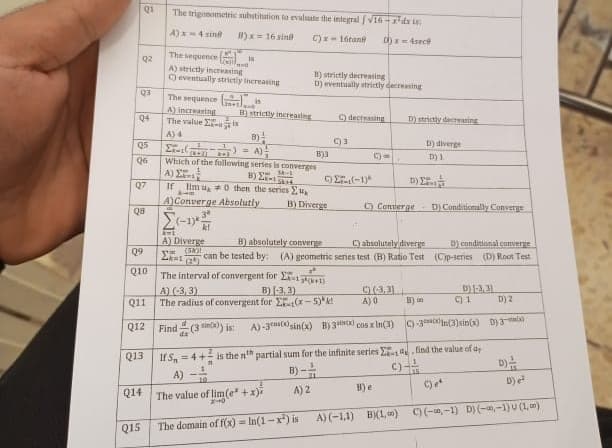Algebra & Trigonometry with Analytic Geometry
13th Edition
ISBN:9781133382119
Author:Swokowski
Publisher:Swokowski
Chapter10: Sequences, Series, And Probability
Section10.1: Infinite Sequences And Summation Notation
Problem 66E
Related questions
Question
Q 5 please

Transcribed Image Text:Q1
02
Q3
04
05
Q6
07
Q8
09
Q10
Q15
Q13
The trigonometric substination to evaluate the integral f√16 - zde is
A)x= 4 ing
B)x= 16 sind
C)x= 16tan
D)x=4sec
The sequence
A) strictly increasing
C) eventually strictly increasing
My
The sequence
A) increasing
The valvin Persialis
A) 4
E-
is
kwi
A) Diverge
(54)
(24)
B) strictly increasing
B)
(8+2)
= A):
Which of the following series is converges
A) Es
B) E-
34-1
If limu, 0 then the series Eu
B) strictly decreasing
D) eventually strictly decreasing
kim
A)Converge Absolutly B) Diverge
3
B)3
1
A)-
Q14 The value of lim(e* + x)
X-0
B) absolutely converge
can be tested by: (A) geometric
The domain of f(x)=In(1-x²) is
decreasing
C) Σ(-1)^
C) 3
SANE
The interval of convergent for E-
C) (3,31
A) (-3,3)
B) -3,3)
A) 0
Q11
The radius of convergent for E(-5) k
Q12 Find(3)) is: A)-3(x) sin(x) B) 3) cos x ln(3)
(F
2
If S=4+ is the nth partial sum for the infinite series
B)-
A) 2
Cabsolutely diverge
series test (B) Ratio Test
B) e
D) strictly decreasing
Converge D) Conditionally Converge
D)
C)
Dy diverge
D) 1
B)
D) conditional converge
(Cip-series (D) Root Test
91
C)-300In(3) sin(x)
find the value of a
D)-3,31
D)
D)e²
A) (-1,1) B)(1) C)(-0₁-1) D) (-0,-1) U (1,0)
Ce*
D) 2
D) 3-
Expert Solution
This question has been solved!
Explore an expertly crafted, step-by-step solution for a thorough understanding of key concepts.
Step by step
Solved in 2 steps with 1 images

Recommended textbooks for you

Algebra & Trigonometry with Analytic Geometry
Algebra
ISBN:
9781133382119
Author:
Swokowski
Publisher:
Cengage

Algebra & Trigonometry with Analytic Geometry
Algebra
ISBN:
9781133382119
Author:
Swokowski
Publisher:
Cengage